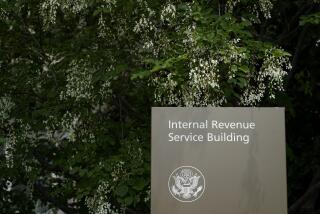Putting the Bite on Tax Cheaters
- Share via
In 1979, according to Internal Revenue Service estimates, tax cheating by individuals and corporations worked to deny the Treasury more than $56 billion that it was legally entitled to collect. By 1981 this tax gap had widened to more than $81 billion. Projecting from that, the IRS foresaw the difference between taxes owed and taxes paid increasing to more than $100 billion by 1987, and to $160 billion by 1990. Now, though, the IRS thinks that it sees signs of growing compliance--meaning less cheating--by taxpayers. IRS Commissioner Lawrence B. Gibbs has told Congress that tax cheating last year may have dropped by a dramatic 20%.
That would bring the tax gap for 1987 down to between $80 billion and $90 billion--numbers showing that there is still a lot of room for improvement, but nonetheless a welcome indication that a reversal may be under way in a trend going back several decades. In the mid-1960s the IRS figured that it was able to collect more than 94% of what it was owed by individuals and corporations. By 1986 it estimated that voluntary compliance in tax payments had plummeted to as low as 81%. Now it seems that the compliance rate may be back up to 90% or so.
Are Americans getting more honest? It would be nice to think so, but it might be more accurate to put it this way: It has been made harder for taxpayers to be dishonest, mainly because it’s no longer as easy as it once was to underestimate income and overestimate deductions.
Better computers have simplified the IRS’ task of comparing income claims on tax returns with what employers, banks and financial institutions are required to report. The revision of the tax code two years ago eliminated many potential deductions and, with them, the chance to fiddle with a lot of numbers. This year, what had become a commonplace scam of inventing dependents has been made a lot harder to carry off. The IRS has estimated that each year 8.3 million non-existent children are listed on tax returns for the purpose of claiming personal exemptions. Now all tax returns must carry a Social Security number for each claimed dependent who is 5 years old or older. This simple change, the IRS thinks, could recover well over $5 billion a year in tax underpayments.
Five billion here, five billion there, it all adds up. Taxpayers who do their best to provide the IRS with an honest accounting each year can only be cheered by the new obstacles that are put in the way of tax cheaters.
More to Read
Inside the business of entertainment
The Wide Shot brings you news, analysis and insights on everything from streaming wars to production — and what it all means for the future.
You may occasionally receive promotional content from the Los Angeles Times.










